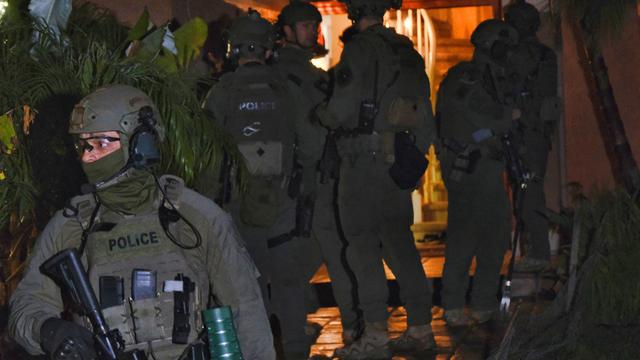Officials from the United States Drug Enforcement Agency (DEA) received information about the transportation of a large amount of cash that would be carried out by drug traffickers in southern California. They were closely watched until two cars were stopped in early April. In the trunks, inside three cardboard boxes, officers found several wads of bills totaling $1.7 million. Later that month, anti-narcotics agents disrupted a drug transaction in Riverside that led to the seizure of $1 million. in cash and 30 kilos of cocaine. Since mid-March, DEA agents in Los Angeles have confiscated a veritable fortune, as much as 10 million dollars, from the operators of the Sinaloa and Jalisco New Generation (CJNG) cartels. That figure doubles the money seized in the same period last year.
The reason? Both criminal organizations accumulated many wads of cash in their lairs, because the quarantine decreed on March 19 in California completely closed the businesses they use to launder money: exporters of clothing, jewelry, cosmetics and sporting goods. That moment was taken advantage of by the DEA to hit the cartels where it hurts them the most: in their illicit profits, the fruit of an increasingly complicated effort to bring their merchandise to the United States. “That money generated by the sale of drugs did not have a destination to go to and began to accumulate very quickly. Just doing our day-to-day work — wiretapping, using informants and doing undercover operations — we started to focus on the big packages of cash,” said William Bodner, DEA Los Angeles bureau chief. “Eventually the traffickers thought: ' we have to move the money'. Which resulted, once again, in taking the money by car to the south (Mexico) and that is when we made the majority of the seizures, “added the official.
So your Strokes are the new side effects from this Corona virus in the Jimmy Carter have an infection in his brain?… https://t.co/w32Xr6ZRx3
— Jacqueline Fritz Sun Apr 26 10:39:30 +0000 2020
Going back to the old system

The method of transporting cash to Mexico using the same cars that traveled north with drugs is becoming less popular with drug traffickers because it carries high risk. In addition, the Mexican government imposed more restrictions on bank cash deposits. Things have changed in a decade. In 2010, the US authorities seized more than 800 million dollars in cash from drug traffickers and since then they have been taking less and less. In 2018, they confiscated 234 million dollars in cash (70% less than ten years ago) in 4,654 incidents. In California alone, they seized $45.3 million, the highest figure recorded at the time. But in recent years, drug traffickers' financial operators began to hand over their cash to export companies in the US that act as representatives of Mexican importers. They call it the 'black market of the peso ' and it consists of taking the cash to the companies so that they, in exchange for a percentage, pay the drug traffickers there in pesos. It is a system that they copied from Colombian traffickers. Six years ago, a mega-operation in the Los Angeles Fashion District, the main money laundering center of the Mexican cartels, revealed everything: they seized some $100 million of dollars to stores used by the criminal organization then led by Joaquín 'El Chapo' Guzmán. Bodner assures that the closure of businesses due to the pandemic in March "immediately" affected that system and put criminals in a dilemma: how to get the money to Mexico, before losing it to law enforcement operations or rival thefts. The DEA knew they were planning to return to the old method and watched them outside their hideouts. In traffic stops they kept most of the $10 million seized. Almost the same amount was taken from the Sinaloa and Jalisco cartels, the largest in Mexico and Los Angeles. “Usually we know through our intelligence when the money is moving. We watched them, we started moving around to make sure everything looked normal, and then we did the traffic stops to seize their money,” Bodner explained. Cartel carriers faced another huge challenge: Southern California highways were empty for the stay-at-home order, exposing them to easy identification. “The risk from traffickers was higher. It is difficult to hide when there is no one on the road and when there are not so many people crossing the border, because the checkpoints were closed only for essential traffic”, Bodner pointed out. ', in which they receive the cash and make transfers from Asian banks or send opioids or chemical precursors necessary to produce methamphetamine to Mexico. The cycle was broken because the place where these substances are most produced in China, Wuhan, is the epicenter of the outbreak of the coronavirus and was once completely closed. "When the border reopens and Mexico solves its problems with the coronavirus and Chinese trade resumes, we will see that the drug business will return to normal," Bodner warned. has not yet filed criminal charges against the money carriers arrested during the quarantine. Bodner explained that the DEA released them and is waiting for a large criminal case to be integrated to re-arrest them in an operation.
Basic Tips on How to Take Good Care of Your Feet
How to Save Money on Your Seaside Trip: Clever Tips for a Frugal Vacation That Won't Sacrifice Fun
Lil Nas X's Unofficial 'Satan' Nikes Containing Human Blood Sell Out In Less Than A Minute
6 Items to Help You Start the Journey of Losing Weight